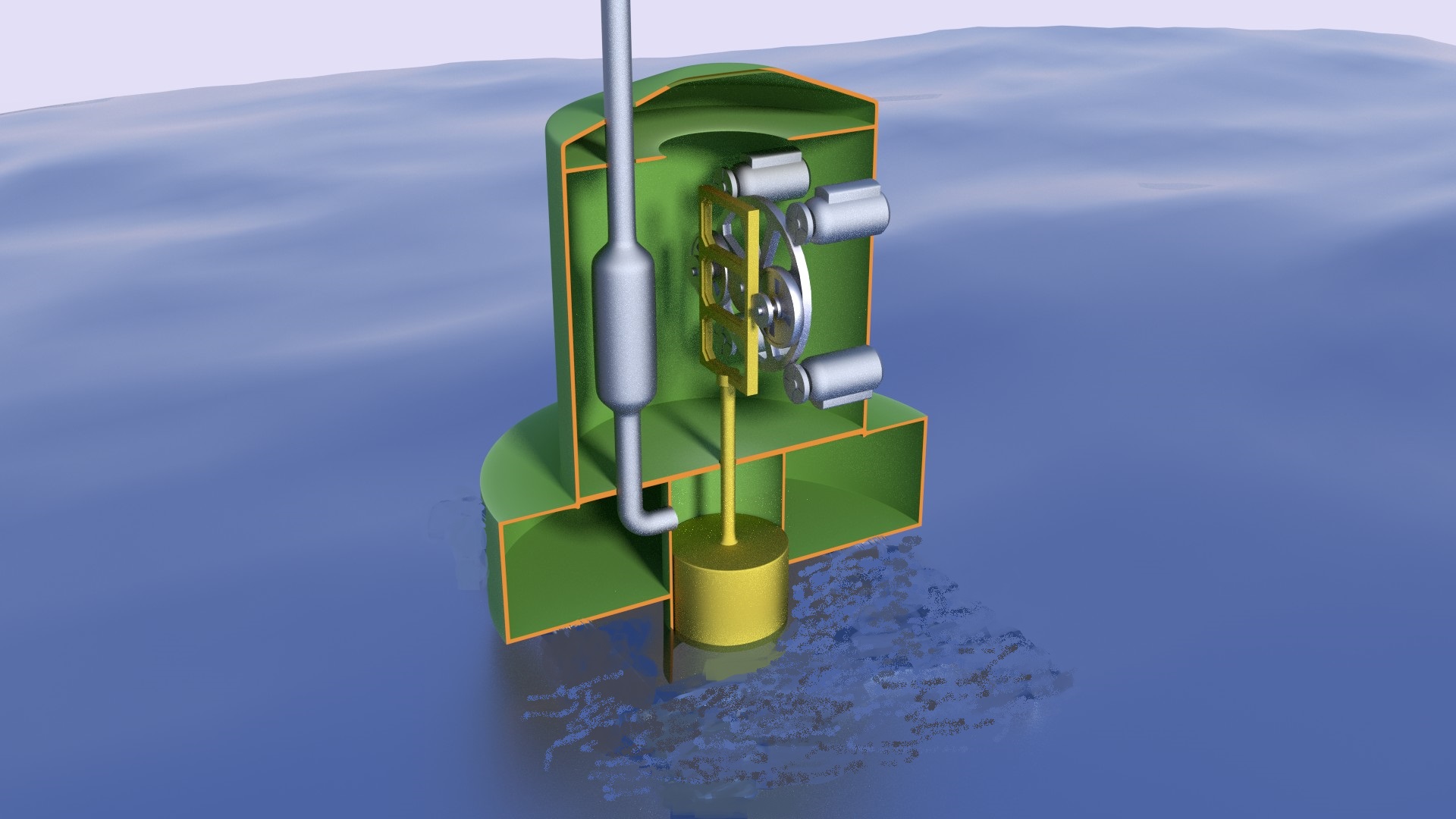
The Hanna MultiDrive
U.S. Patent 8,745,981
The patent for the MultiDrive PTO has been assigned.
Go to the USPTO website to view information on the new owner.

"Ocean Powered Take-off for Multiple Rotary Drives"
The simple sketch above, illustrates the patented Hanna power take-off (PTO). The system is unique because it uses two different types of wave energy converters. The illustration shows both power sources used in the system: a mechanical direct-drive PTO and a self-rectified, mono-radial air turbine. The rendering shows how the wave energy converter might be utilized in a surface buoy configuration. The buoy is a single point, slack-moored floating platform that rises and falls with the incident waves. Inside the buoy, the float rises and falls in resonant frequency with the free surface of water contained within. The float's motion drives both the mechanical direct-drive PTO and the self-rectified turbine simultaneously. Both PTO's convert the up and down linear movement into a one way rotary movement, spinning multiple generators.
The buoy can also be deployed as a subsurface wave energy converter (U.S. patent application 62/606,589). The subsurface device is versatile; it can generate electricity by choosing from three optional PTO's: a linear internal Float, a self-rectified turbine or an impeller drive. To see details on the special subsurface buoy, click HERE.
In the surface buoy configuration, called the Hanna MultiDrive, a Float and Shaft will rise and fall with the sinusoidal motion of the buoy's internal water levels. The Float and Shaft are contained inside a tubular enclosure that has openings below and above the water surface. Thus, the enclosure is a typical Oscillating Water/Air Column system. However, the surface buoy design is but one application of this versatile device. The PTO can also be installed on jetties or breakwaters. The PTO can be integrated into the design of off shore oil rigs and floating wind and wave harvesting structures.
The reciprocating Shaft is a linear rack gear that drives a rotary pinion. The patented arrangement of gears that make up the PTO can easily be modified to optimize the gear ratios. The bi-directional linear movement is directly converted into a unidirectional rotary force. This rotational, one-way force efficiently drives multiple generators and/or pumps in one continuous direction.
The PTO uses 100% of the wave cycle. With a favorable wave climate, the direct-drive system will turn a plurality of permanent magnet generators continuously, in only one direction. The generators will produce a smooth and sustained power output! The design directly couples a unidirectional flywheel to spin multiple generators for redundancy and reliability. The flywheel's mass and angular momentum provides high rotational speeds. Up to eight special air-cored generators connected in a parallel circuit configuration will develop 150 Kw. The air-core design eliminates magnetic drag on the flywheel's forward momentum.
An alternative to using multiple generators would eliminate the smaller generators altogether and utilize the flywheel as a stand-alone, radial-flux generator. Powerful magnets will be embedded in the flywheel's outer periphery. The generator's 'stator' windings are made up of multiple'C'-shaped, air-cored copper coils which shroud the spinning magnets to produce utility-scale power for the grid. The generator's annular design is a specialized low-speed topology which has been developed specifically for wave energy converters. The design virtually eliminates the large unwanted magnetic attraction forces that exist in conventional iron-core generators.
The highly adaptive MultiDrive system doubles energy harvesting capabilities when used in conjunction with the Hanna Mono-Radial self-rectified turbine design (click HERE to read the turbine patent application). The turbine will provide additional power to the grid or provide back up power to charge batteries and serve other onboard energy needs. The driving force for the turbine comes from compressed air that is created as a bi-product of the internal Float's upward motion. This air would normally be exhausted from the Float enclosure and released into the atmosphere. But instead, the surplus air is smartly directed through a self-rectifying turbine to increase the buoy's power output. A buoy farm or shore-based power plant that leverages these two combined technologies would have the greatest level of reliability and of any other wave energy conversion system currently in the global market.
https://www.youtube.com/watch?v=uwsm-FWjlQE
Click on the YouTube address above to view a video that demonstrates how the rise and fall of ocean waves are converted into a rotational force. In the full-size, utility-grade device, the flywheel will turn freely under its own momentum between irregular wave sets. The flywheel's spinning mass will provide a sustained wave-to-wire efficiency over a wide range of sea conditions.
wetgen@gmail.com